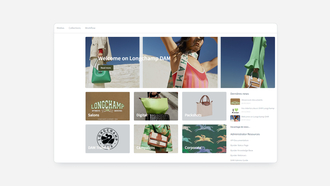The reasons we love a certain brand of sneakers probably have more to do with our brains than our feet.
As consumers, we like to think we favor a brand because of objective factors, such as product quality or price. But insights from psychology suggest that our feelings and identities may have a greater influence than we’d expect on which brands we choose. In fact, a study of 1400 advertising campaigns over the last three decades found that ads with purely emotional messaging performed twice as well as those that were more rational and practically minded (31% vs. 16%).
So what does that mean for brands and their approaches to communicating to their target customers? Are story-driven marketing campaigns that pack an emotional punch really the key to lasting loyalty?
In this article, we’ll cover the ins and outs of emotional decision-making among consumers, as well as the role of brand and social identities. Marketers can use these principles to better understand what motivates their customers, and deliver effective content experiences that keep customers coming back for more.
Emotions: at the heart of brand choices
You might think you chose your brand of toothpaste because it’s the best at preventing cavities or because it’s the best value. But even if you didn’t realize it, emotions likely factored into your decision.
Evidence suggests that emotions may influence our behavior as consumers more than we’d like to admit. According to Peter Noel Murray, a consumer psychologist in New York, fMRIs show that consumers evaluate brands mostly based on emotions rather than information or facts about the brand.
Supporting the findings of the aforementioned study in the intro, their research reveals that a consumer's emotional response to a brand’s ad has a far greater influence on their reported buying intent for a product than the actual contents of the ad itself—strikingly by a ratio of 3-to-1 for TV commercials and 2-to-1 for print ads.
Granted, the role of emotions in consumer decision-making is hardly news to most businesses. From the long-established supermarket strategy of placing produce and flowers at the front of the store to generate a feeling of “freshness”, to clothing retailers that play music that makes shoppers feel like they’re at a hip nightclub (which actually makes shoppers move faster, without reducing sales), examples of businesses harnessing the power of emotion to sell are everywhere.
But when it comes to branding and their supporting customer experiences, marketers often exaggerate the practicalities, lauding the latest and greatest features and benefits of their products and/or services, while often neglecting the personal touch that will really resonate with the individual consumer.
With that in mind, today’s brands would do well to master the art of storytelling that research has proven time and time again to be such an influential factor for much of our audience’s purchasing decisions.
I am what I buy: how brands form identity
In 2006, Apple launched its "Get a Mac" campaign. The campaign featured a series of commercials that featured a young, hip guy in a hoodie introducing himself by saying “Hi, I’m a Mac.” A nerdy, older man wearing a blazer and glasses portrayed another tech brand (you can probably guess which one.) The campaign implied that the computer you use signifies the kind of person you are, and of course, you want to be young and cool, like a Mac.
Many of us may roll our eyes and feel like we’re not so easily swayed to choose one brand over the other because of something that tells us almost nothing about the actual products they’re advertising. Yet the “Get a Mac” campaign turned out to be a huge success for Apple.
Over 15 years later, the emotional tropes displayed in the campaign still stick in our minds when we think about both brands. What Apple’s ad campaign did so well was to associate their brand with an emotionally-charged and personable identity that remains connected to their brand to this day. As any psychologist will tell you, identity and the urge to belong is a powerful social concept that relates to how we view and define ourselves and others. We use many elements of our lives, from physical characteristics (“I’m short”) to political views (“I’m liberal”), to construct our identities—and brands are no different.
Read: The world’s most valuable brand – Apple’s secret to success
So how does this psychological phenomenon tangibly relate to the business world? Consumers construct their identities and present themselves to others through the brands they choose. For instance, you may love a certain brand of hybrid cars because you see yourself as environmentally conscious, or because you want other people to view you that way.
Researchers Jennifer Edson Escalas and James R. Bettman found that college students tended to have positive associations with brands that reflected images that were consistent with their own identity, such as “conservative,” “hippy,” or “athletic.”
Identity may explain why many of the best-loved brands communicate personality traits that consumers identify with or wish to emulate, such as being young, tech-savvy, wealthy, or sexy. If your brand doesn’t resonate with your customer’s real or desired identity, it’s unlikely your brand will inspire love.
Struggling to find a home for your brand identity? See how Bynder’s Brand Guidelines can bring yours to life and ensure better brand consistency.
The power of social identity in branding
If you’ve ever felt a connection to people who use the same kind of smartphone or ride the same brand of motorcycle as you do, you’ve experienced social identity in branding.
Social identity, a component of personal identity, involves defining ourselves based on membership in certain social groups. Individuals might derive social identity from belonging to a fraternity, living in a particular neighborhood, or being a member of a professional organization. Social identity is relevant to brands because of the way social groups influence individuals’ choices and preferences.
A study on solar panel installation demonstrates how the communities we live in can affect our purchasing decisions. Solar panels can be costly to install, so you might assume that only people who see themselves as wealthy or environmentally conscious might install them. But researchers discovered that the most predictive factor in determining where solar panels were installed wasn’t wealth or identifying with liberal political values, but whether someone’s neighbors had installed solar panels. A single solar panel installation increased the average number of solar panel installations within a mile by a factor of 0.44, or almost half.
Many advertising campaigns rely on social identity, suggesting that other members of the target customer’s social group—health-conscious mothers, for example—use a product. Some brands have created social networks exclusively for their customers, essentially forming a social group around their products. Consumers may be more likely to adopt a brand if their social group does, too.
Our brand identity is important for everything we do across our marketing, apps, and various partnerships. Bynder does a great job of ensuring there is a level of brand continuity across all these different touchpoints.Jenna Wolfenden
Creative Ops Program Manager at DraftKings
Building a brand consumers love starts from within
From powerfully emotive ad campaigns to personable social media posts, the digital experiences you promote online are integral to building a lasting emotional connection with consumers — maybe even more so than your actual brand’s products/services.
So how does your brand ensure it's delivering consistent content experiences online that foster a shared identity with consumers, cuts through the digital noise from competitors, while doing so on the right channels at the right time?
With a centralized digital asset management platform, stakeholders both inside and outside your marketing team can collaborate and access content on demand from one single system of record, meaning faster time to market and better control over how and when your content should support and nurture the connections you have with your audiences.
Photography is a huge part of our brand. All our collateral—from brochures to social media posts— relies on powerful, emotive photography. Without a system to filter and tag our thousands of photos, we were only accessing a small percentage of our entire library of images.Maggie Farrand
Senior Officer of Digital Media at Pathfinder International
Branding consistency helps us create more brand equity across the globe. People recognize our brand—and having the right people, processes and technology in place enable that global brand recognition.Molly Catalano
VP of Marketing & Communications at Five Guys
See how some of today’s favorite brands are benefitting from DAM
Over 4000 organizations worldwide use Bynder as their brand’s digital home for delivering powerful content experiences that keep customers coming back for more. Read the success stories here.
From centralized file storage and secure asset sharing to better brand consistency and project collaboration, we have a tailored solution to fit the needs of each and every business. Why not see what Bynder can do for your brand with a free demo?
















